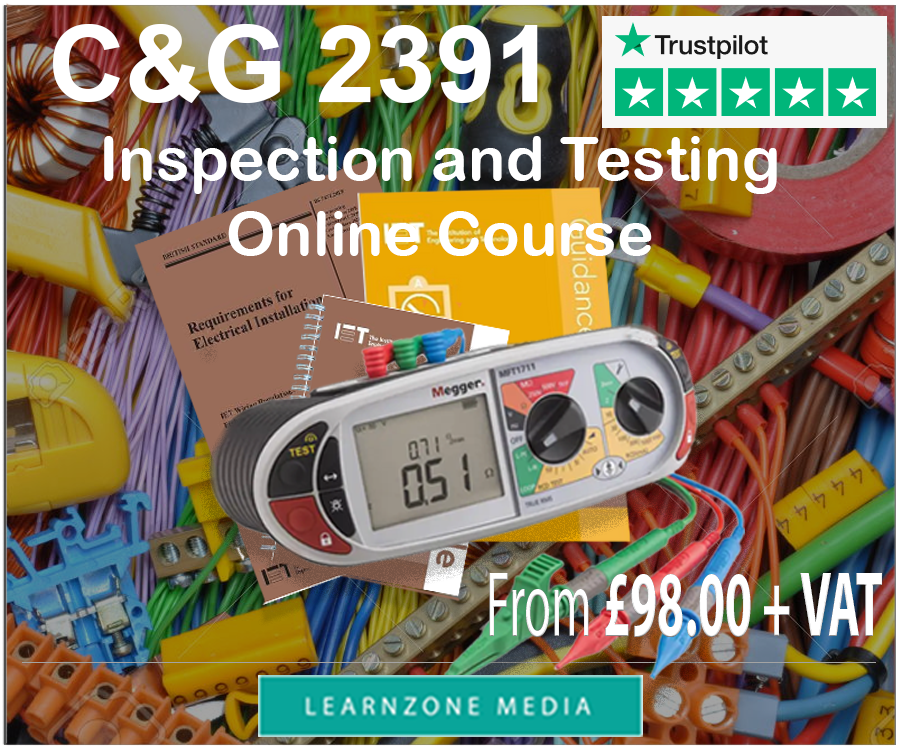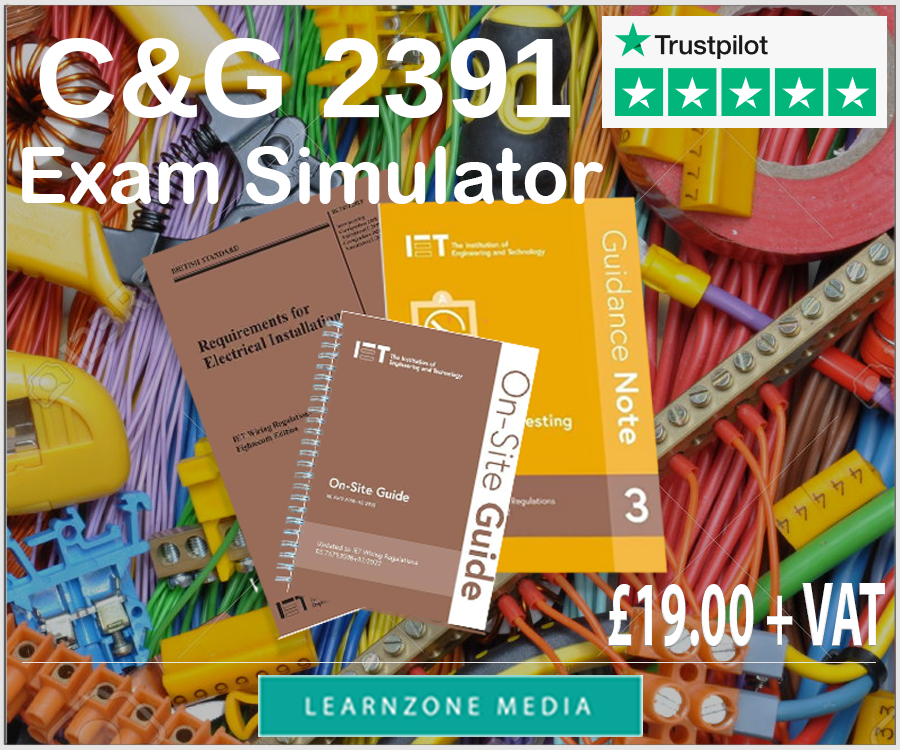C&G 2391 Unit 301 - Sample Test No:3
This is practice test number three for the C&G 2394 - 2395 multiple choice exams. The sample test below has 40 questions, the same number as the online exam. The allowed time for the exam is 1 hour and 20 minutes. You will find the answers on the last page.
1. The neutral of the supply cable is used as part of the earth return path in which of the following systems:
a) TT
b) TN-C
C)
TN-S
d) TN-C-S
2. The Electricity at Work Regulations concern:
a) All aspects of electrical systems
b) Systems up to 1000 volts
c) Special locations only
d) High voltage systems only
3. On completion of periodic testing an old domestic installation, the insulation resistance is found to be below the requirements of BS 7671. The immediate action to be taken is to:
a) Notify the local supply authority
b) Notify the person ordering the work
c) Put a warning notice on the supply intake position
d) Protect the circuits with smaller sizes of fuses
4. On a new installation, which one of the following should be made available to the person conducting the inspection and test:
a)
Details of the customer
b) Schedule of test results
c) Relevant charts, tables and diagrams
d) Previous test results
5. Regional electricity companies quote a maximum likely value of external loop impedance (outside the consumer's installation) for a TN-C-S system as:
a) 0.35 ohm
b) 0.8 ohm
c) 21 ohm
d) 200 ohm
6. When using a centre-contact (ES) lampholder, the outer contact must be connected to the:
a) Phase conductor
b) Neutral conductor
c) Circuit protective conductor
d) Switch wire
7. For proving a circuit has been safely isolated, the electrical safety council recommend using,
a) A voltage stick
b) A multimeter
c) A proving unit
d) A two pole voltage detector
8. The non statutory document concerning the care and use of test instruments, leads and probes would be:
a) BS7671 wiring regulations
b) Guidance note 3
c)
Guidance note GS38
d) The Electricity At Work Regulations
9. On a new installation, which of the following should be made available to the person conducting the inspection and test:
a) Customer contact details
b) Schedule of test results
c) Relevant charts
d) Previous test results
10. It is recommended that tests instruments are nulled in order to,
a) Provide accurate readings
b) Ensure calibration
c) Start from zero
d) Conserve battery power
11. A reason for testing the prospective fault current would be to,
a) Ensure the protective device will disconnect within given parameters
b) Ensure that the correct circuit protection devices are selected
c) Verify the installation
d) Calculate the external loop impedance
12. The safest method of making sure an installation is safe to work on would be,
a) To check the installation with a Fluke tester
b) To ensure the RCDs are functional
c)
To isolate the installation at the main cut-out
d) To follow safe isolation procedure
13. It is important to keep records of test equipment, usually via the serial number, because
a) The instrument can be traced in case of an anomaly
b) It is an EAWR requirement
c) It may be needed for the warranty
d) Different users use different testing equipment
14. Which of the following instruments must be used to measure the earth electrode resistance for a standby generator?
a) Earth fault loop impedance tester
b) Insulation resistance tester
c) Low resistance ohm meter
d) Earth electrode resistance tester
15. Which of the following describes the connection arrangements at the incoming DNO terminals for the earthing conductor in a 230V single-phase TN-C-S supply?
a) The supplier's neutral and the installation earthing conductor are connected together
b) The earthing conductor is connected to a separate conductor in the supply cable
c) The earthing conductor is connected to a consumer`s earth electrode
d) The earthing conductor is connected to earth through a sufficiently high impedance
16. Which of the following is not a method used to determine that automatic disconnection of supply for a final circuit is achieved?
a) Direct measurement of Zs at the furthest point of the circuit
b) Adding the measured value of R1+R2 to Ze found by enquiry
c) Adding the measured Ze to the measured R1+R2 for the circuit
d) Measuring the prospective fault current at the furthest point on the circuit
17. Which of the following protective devices is not suitable to be used to disconnect fault currents in excess of 10kA?
a) BS 3036 fuse
b) BS 88-3 fuse
c) BS 88-2 fuse
d) BS En 60898 circuit breaker
18. Given the following numbered tests, select the sequence in which these tests should be conducted for a new installation:- 1. functional 2. insulation resistance 3. polarity 4. continuity of final ring conductors 5. continuity of protective conductors:
a) 5,4,2,3,1
b) 4,5,3,2,1
c) 1,3,4,5,2
d) 2,3,4,5,1
19. Statement 1 - A polarity test is carried out with a loop tester Statement 2 - A polarity test can confirm correct connection of conductors within an Edison Screw lamp:
a) Statement 1 is true, statement 2 is false
b) Both statements are true
c) Statement 1 is false, statement 2 is true
d) Both statements are false.
20. Which test requires you to measure the resistance from the earth at the Consumer Unit to the furthest earth connection in the circuit:
a) Magnetic Field Test
b) Continuity
c) Insulation Resistance
d) Polarity





